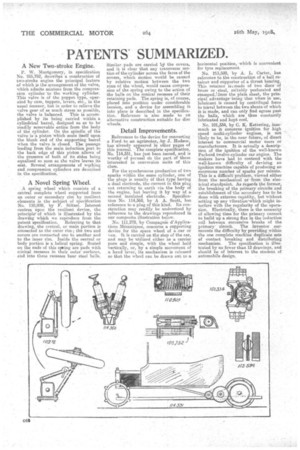PATENTS' SUMMARIZED.
Page 22

If you've noticed an error in this article please click here to report it so we can fix it.
A New Two-stroke Engine, P. W. Montgomery, in specification No. 105,752, describes a construction of two-stroke engine the principal feature of which is the arrangement of the valve, which admits mixture from the compression 'cylinder 'to the working cylinder. This valve is of the poppet type, operated by cam, tappets, levers, etc., in the usual manner, but in order to relieve the valve gear of as much stress as possible, the valve is balanced. This is accomplished by its being carried within a cylindrical barrel, designed so as to be readily removable entire from the body of the cylinder. On the spindle of the valve is a piston 'which seats itself upon the blank end of the supporting barrel when the valve is closed. The passage leading from the main induction port to the back edge of this piston allows of the pressure of both of its sides being equalised so soon as the valve leaves its seat. Several arrangements of working and compression cylinders are described in the specification. •
A Novel Spring Wheel.
A spring wheel which consists of a central complete wheel supported from an outer or secondary rim by resilient elements is the subject of specification No. 110,909, by F. Stitzel. Interest centres upon the resilient device, the principle of which is illustrated by the drawing which we reproduce from the
patent specification. Referring to that drawing, the central, or main portion is connected to the fluter rim; the two end covers are connected one to another and to the inner rim. Inside the central or body portion is a helical spring. Seated on the ends of this spiting are pads with co-nical recesses in their outer surfaces, and into these recesses bear steel balls. S-milar pads are carried bY the covers, and it is clear that any transverse root on of the cylinder across the faces of the covers, which motion would be caused by relative motion between the two rims of the wheel, would cause compression of the spring owing to the action of the balls on the conical recesses of their retaining pads. The spring is, of course, placed into position under considerable tension, and a device for assembling it into place is described in the specification. Reference is also made to an alternative construction suitable for disc wheels.
Detail Improvements.
References to the device for converting a Ford to an agrimotor, -by J. Hodson, has already appeared in other pages of this journal. The complete specification, No. 114,331, has just been issued, and is worthy of perusal dn the part of -those interested in conversion units of this class.
For the synchronous production of two sparks within the same cylinder, one of the plugs is usually Of that type' having a dual electrode, the current in this plug not returning to earth via the body of the engine, but leaving it by way of a second insulated electrode. Specification 'No. 114,368, by -A A. Scott, has reference to a plug of this kind. Its construction may readily be understood by reference to the drawings reproduced in our composite illustration below.
No. 111,278, by Coinpagnie il'Applications Mecaniques, concerns a supporting device for the spare wheel of a -car or van. It is carried on the step of the car, and may be utilized either as a carrier pure and simple, with the wheel held vertically, or, by a simple movement of a hand lever, its mechanism is released so that the wheel can be drawn out to a
horizontal position, which is convenient for tyre replacement.
No. 113,599, by A. L. Carter, has reference to the construction of a )3;11 retainer and supporter of a thrust bearing. i This retainer s,t made of two discs' of brass or 'steel, suitably perforated and stamped, from the plain sheet, the principal advantage-being that when in use, lubricant is caused by centrifugal force to travel between the two sheets of which it is made, and can only find egress past the balls, which are thus constantly lubricated and kept cool.
No. 101,334, by C. K. Kettering, inasmuch as it concerns ignition for high speed multi-cylinder engines, is not likely to be, in the near future, of direct interest to commercial motor users or manufacturers. It is actually a description of the ignition of the well-known Packard twelve-cylinder car. engine. The niakers have had to contend with the well-known difficulty of devising an 'ignition machine capable of producing an enormous number of sparks per minute. This is a difficult' problem, viewed either from the mechanical or from the electrical standpoint. As regards the former, the breaking of the primary circuits and establishment of-the secondary has to be done with extreme rapidity, but without setting up any vibration'which might interfere with the regularity of the operation. Electrically, there is the necessity of allowing time for the primary current to build up a strong flux in the induction coil between successive breaks of the
primary' circuit. The inventor surmounts the difficulty by providing within the one complete machine duplicate setts of -contact breaking and distributing mechanism. The specification is illustrated by no fewer than 13 drawings, and should be of interest to the student of automobile design.






















